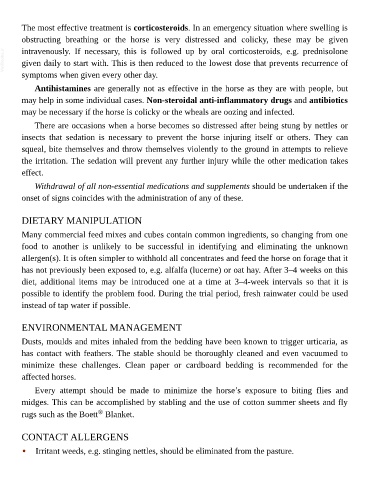Page 856 - The Veterinary Care of the Horse
P. 856
The most effective treatment is corticosteroids. In an emergency situation where swelling is
obstructing breathing or the horse is very distressed and colicky, these may be given
VetBooks.ir intravenously. If necessary, this is followed up by oral corticosteroids, e.g. prednisolone
given daily to start with. This is then reduced to the lowest dose that prevents recurrence of
symptoms when given every other day.
Antihistamines are generally not as effective in the horse as they are with people, but
may help in some individual cases. Non-steroidal anti-inflammatory drugs and antibiotics
may be necessary if the horse is colicky or the wheals are oozing and infected.
There are occasions when a horse becomes so distressed after being stung by nettles or
insects that sedation is necessary to prevent the horse injuring itself or others. They can
squeal, bite themselves and throw themselves violently to the ground in attempts to relieve
the irritation. The sedation will prevent any further injury while the other medication takes
effect.
Withdrawal of all non-essential medications and supplements should be undertaken if the
onset of signs coincides with the administration of any of these.
DIETARY MANIPULATION
Many commercial feed mixes and cubes contain common ingredients, so changing from one
food to another is unlikely to be successful in identifying and eliminating the unknown
allergen(s). It is often simpler to withhold all concentrates and feed the horse on forage that it
has not previously been exposed to, e.g. alfalfa (lucerne) or oat hay. After 3–4 weeks on this
diet, additional items may be introduced one at a time at 3–4-week intervals so that it is
possible to identify the problem food. During the trial period, fresh rainwater could be used
instead of tap water if possible.
ENVIRONMENTAL MANAGEMENT
Dusts, moulds and mites inhaled from the bedding have been known to trigger urticaria, as
has contact with feathers. The stable should be thoroughly cleaned and even vacuumed to
minimize these challenges. Clean paper or cardboard bedding is recommended for the
affected horses.
Every attempt should be made to minimize the horse’s exposure to biting flies and
midges. This can be accomplished by stabling and the use of cotton summer sheets and fly
®
rugs such as the Boett Blanket.
CONTACT ALLERGENS
• Irritant weeds, e.g. stinging nettles, should be eliminated from the pasture.

